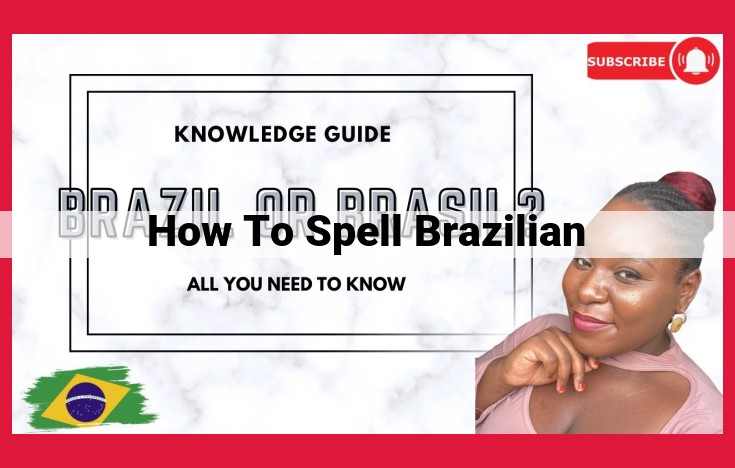
Guide To Spelling “Brazilian” In Accordance With The 1943 Reform
To spell "brazilian," ensure it is lowercase and follows the spelling reform of 1943. Avoid using accents on "a" and "o" except when part of a diphthong or tonic accent. Replace "ç" with "ss" ('brasileiro'). For plurals, use "s" or "es" according to the noun gender. For possessive adjectives, use "meu," "minha," "teu," "tua," "seu," "sua," etc.
Key Figures in Brazilian Portuguese Language Development
The evolution of Brazilian Portuguese is a captivating story, shaped by the contributions of visionary individuals who dedicated their lives to nurturing its growth.
Antônio de Moraes Silva, a lexicographer, paved the way in the 18th century by compiling the Dicionário da Língua Portuguesa. His meticulous work provided a solid foundation for the standardization of Brazilian Portuguese vocabulary.
João de Barros, a renowned historian, played a pivotal role in documenting the origins and nuances of Brazilian Portuguese. His writings, penned in the 16th century, captured the linguistic landscape of the time.
In the 19th century, Gonçalves Dias, a poet and philologist, celebrated the beauty and diversity of Brazilian Portuguese. His literary masterpieces resonated with audiences, fostering a sense of national pride and appreciation for the language.
Monteiro Lobato, a prolific writer, is revered as the "Father of Brazilian Children's Literature". Through his beloved characters and imaginative stories, he introduced generations of young Brazilians to the wonders of their language.
Cecília Meireles, a renowned poet and educator, refined and elevated the aesthetics of Brazilian Portuguese. Her lyrical poems and insightful essays left an indelible mark on the language's literary heritage.
These luminaries, and many others, have dedicated their lives to shaping, preserving, and promoting Brazilian Portuguese. Their contributions have enriched the language and made it a vibrant and expressive voice for the people of Brazil.
Institutions Shaping Brazilian Portuguese
Throughout history, various institutions have played pivotal roles in the standardization, preservation, and research of Brazilian Portuguese. Among them, three stand out: the Academia Brasileira de Letras (ABL), the Instituto de Letras da Universidade Federal do Rio de Janeiro (IL-UFRJ), and the Instituto de Estudos da Linguagem (IEL-UNICAMP).
Academia Brasileira de Letras (ABL)
Founded in 1897, the ABL is the oldest and most prestigious literary institution in Brazil. Its mission includes safeguarding the purity of Brazilian Portuguese and promoting its literary excellence. The ABL publishes influential works such as the Vocabulário Ortográfico da Língua Portuguesa (VOLP), the official orthographic dictionary for Portuguese in Brazil.
Instituto de Letras da Universidade Federal do Rio de Janeiro (IL-UFRJ)
Established in 1937, the IL-UFRJ is a renowned research center dedicated to the study of linguistics and literature. Its graduate programs in Portuguese linguistics are among the most respected in the country. The IL-UFRJ has played a significant role in the standardization of Brazilian Portuguese through its research on grammar, phonology, and syntax.
Instituto de Estudos da Linguagem (IEL-UNICAMP)
IEL-UNICAMP is a multidisciplinary research institute focusing on language studies. It was founded in 1976 and is affiliated with the Universidade Estadual de Campinas (UNICAMP). IEL-UNICAMP has made important contributions to the understanding of Brazilian Portuguese, particularly in the areas of etymology, sociolinguistics, and discourse analysis.
Essential Reference Works for Brazilian Portuguese
Unlocking the Treasures of the Lingua Portuguesa
When embarking on a journey to master Brazilian Portuguese, it is imperative to equip yourself with reliable and comprehensive reference works. Among the myriad of resources available, two stand out as indispensable tools for correct spelling, grammar, and vocabulary:
1. Dicionário Houaiss da Língua Portuguesa
Considered the gold standard of Brazilian Portuguese dictionaries, the Dicionário Houaiss is a meticulously compiled tome that captures the vast lexicon and intricacies of the language. Its exhaustive definitions, etymologies, and usage examples make it an invaluable resource for writers, students, and language enthusiasts alike.
2. Vocabulário Ortográfico da Língua Portuguesa (VOLP)
The official spelling guide of Brazil, the VOLP provides definitive guidance on the correct spelling of words. Its comprehensive list of Portuguese words and their standardized spellings ensures that your written communication adheres to established norms.
With these essential reference works in hand, you can confidently navigate the linguistic landscape of Brazilian Portuguese, unlocking its richness and nuances.
Key Concepts in Brazilian Portuguese Evolution
Defining Brazilian Portuguese: A Distinct Variety
Brazilian Portuguese, a vibrant and distinct variety of the Portuguese language, emerged as a product of Brazil's unique history and cultural evolution. Over centuries, the language absorbed influences from indigenous languages, African dialects, and European immigration, creating a rich tapestry of linguistic diversity. Brazilian Portuguese stands today as a vibrant expression of Brazil's cultural identity, spoken by over 200 million people worldwide.
Shaping Influences: Spelling Reform and Etymology
The evolution of Brazilian Portuguese has been marked by significant linguistic shifts. In 1945, a comprehensive spelling reform simplified the language's orthography, aligning it more closely with spoken pronunciation and making it more accessible to Brazilians. This reform had a profound impact on the way words were written and spelled, creating a more standardized and streamlined writing system.
Etymology, the study of word origins, reveals the diverse linguistic influences that have shaped Brazilian Portuguese. The language's extensive vocabulary has been enriched by loanwords from indigenous languages, such as "capoeira" (a martial art) and "guava" (a tropical fruit). African words, like "candomblé" (a religious tradition) and "acarajé" (a street food), also left an enduring mark on the language. European languages, including Spanish, French, and English, contributed further to the vocabulary, reflecting Brazil's multicultural heritage.
Related Topics:
- Say “God Bless You” In Arabic: A Guide To Expressing Gratitude And Blessings
- Unveiling The Nuances Of Chinese Vocabulary And Cultural Practices For Poop
- Step-By-Step Guide To Wearing A Bonnet For Optimal Style And Comfort
- Mastering Vocabulary Closeness: Enhance Your Spanish Fluency
- How To Pronounce “Diabetes Mellitus” Correctly: A Comprehensive Guide